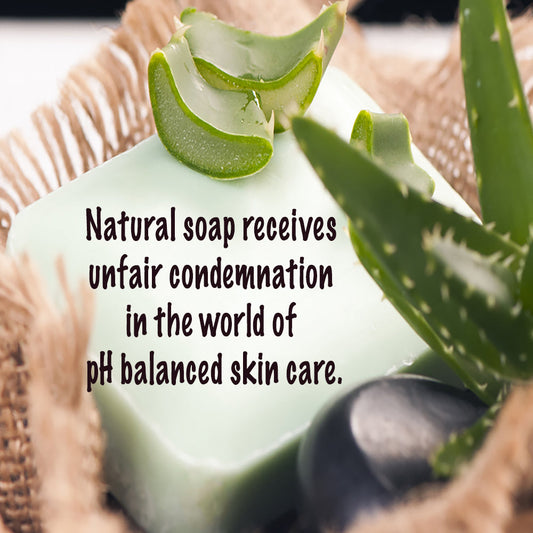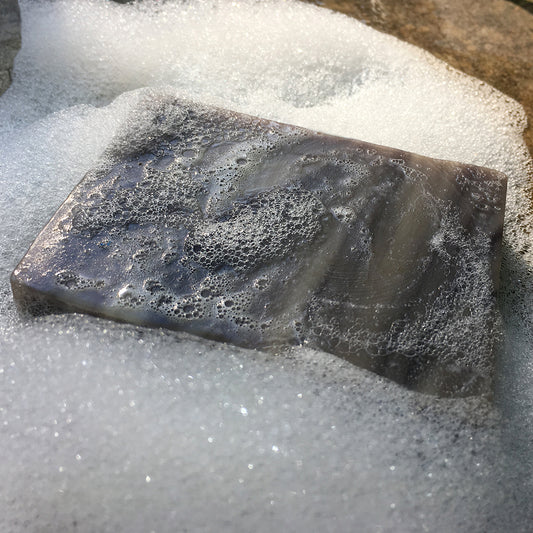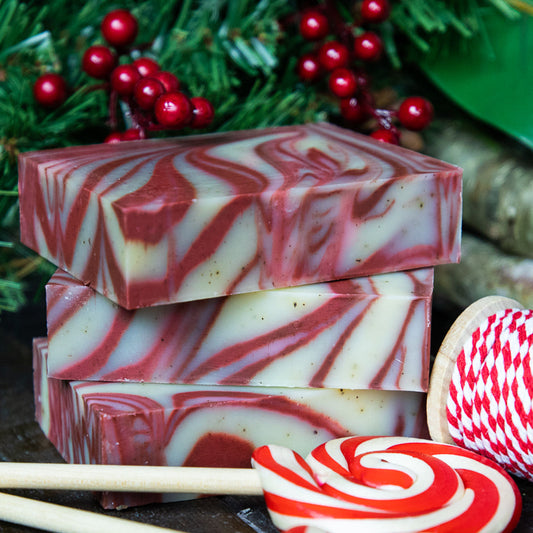Is There Lye In Natural Soap?
Won't It Harm My Skin?
If you are asking the question:
Do you use lye (sodium hydroxide) to make Chagrin Valley natural soap?
The answer is -- yes, of course.
No lye -- No soap!
All REAL soap is made with lye (sodium hydroxide mixed with a liquid).
Any skin or hair cleansing product made without sodium hydroxide is not soap, it is a detergent.
If you are asking the question:
Is there lye in a bar of Chagrin Valley Natural Soap or Shampoo?
The answer is "No."
When the process of making soap, called saponification, is complete, the lye and oil molecules have combined and chemically changed into soap and glycerin.
If the soap is made correctly, the lye is used up in the saponification process to turn oil into soap.
There is no lye present in the finished bars of soap or shampoo. While all real soap must be made with lye, no lye remains in our finished product after saponification (described below).
It Doesn't Say "Lye" or "Sodium Hydroxide" on My Soap Bar Ingredients
If it is real soap or contains real soap, it must be made with lye!
Handmade natural soap and some commercial "soap" bars are made with lye even though the words "sodium hydroxide" or "lye" do not appear on the labels. Does your bar of "soap" contain ingredients such as...
- saponified oils: oils and butters are mixed with sodium hydroxide and a liquid (usually water).
- sodium cocoate: the generic name for the mixture of coconut oil with sodium hydroxide (lye).
- sodium palmate: the generic name for the mixture of palm oil with sodium hydroxide (lye).
- sodium palm kernelate: the generic name for the mixture of palm kernel oil with sodium hydroxide (lye).
- sodium tallowate: the generic name for the mixture of beef fat (tallow) with sodium hydroxide (lye).
- sodium olivate: the generic name for the mixture of olive oil with sodium hydroxide (lye).

We once had a customer who returned a bar of our natural Castile & Shea soap because her dermatologist told her that she should not use any soap made with lye.
So, what did he recommend? Dove.
It is true that the words "lye" or "sodium hydroxide" do not appear on the Dove ingredient label.
But, the first ingredients listed were sodium tallowate, sodium cocoate, and sodium palm kernelate. So you can guess what I told her! Yes, Dove is made with lye!
These alternative words are not always used to deceive consumers!
Many handmade soap makers or companies leave out the words "sodium hydroxide" (lye) from their ingredient lists because of misinformation and fear among consumers. They often choose to use the words "saponified oils" instead.
At Chagrin Valley we believe that today's consumers are pretty savvy and the best practice is to educate. Besides, as a USDA Certified Organic Company we are required to list every ingredient on our product label.
What is Sodium Hydroxide?
Sodium hydroxide, also known as lye, is needed for the saponification reaction which is at the heart of soap-making.
You can not make real soap without lye. Remember, No lye, No soap!
 Old-fashioned lye was made using hardwood ashes, a barrel or ash hopper, and rainwater.
Old-fashioned lye was made using hardwood ashes, a barrel or ash hopper, and rainwater.
Unfortunately, since there was no standard dilution, there was no way to determine if the lye water was the correct strength.
That is why granny’s old-fashioned “lye soap” was often lye-heavy and had the reputation of being drying and irritating to the skin.
In case you are a bit of a science nerd like me, here is an extremely simplistic chemistry explanation of how sodium hydroxide is made today.
While lye is manufactured in a laboratory, it is just a salt made of sodium, hydrogen, and oxygen. Sodium hydroxide (NaOH), which consists of sodium ions (Na) and hydroxide ions (OH), can be made from salt water.
In salt water, we have two compounds: sodium chloride (NaCl) and water (HOH). Using a process called electrolysis, in which an electric current is passed through the salt water, the water is split into hydrogen gas (H) and hydroxide ions (OH-) and the salt into chlorine (Cl) gas and sodium (Na+) ions.
Now, the sodium ions (Na+), which are positively charged, can combine with the negatively charged hydroxide (OH-) ions to form NaOH. Voila! You made sodium hydroxide from simple salt water.
Cold-processed soap is considered natural because the lye (sodium hydroxide), used in the saponification process to convert oils and fats into soap, is not present in the final product.
Since sodium hydroxide is also used in organic agriculture, it is allowed by the USDA to be used in certified organic products.
Saponification: The Chemical Reaction Of Soapmaking
(The Science teacher in me could not resist this simple explanation)
If you dig deep back to your high school chemistry days, you may remember learning about acid-base reactions. When an acid and a base combine, they neutralize each other and usually make a salt.
In simple terms, saponification is the name for a chemical reaction between an acid and a base to form a salt called "soap."

Sodium hydroxide is the alkali (base) and the acids are the fatty acids that make up the triglycerides present in oils and butters.
For each unique soap recipe, a precise amount of fat (oils and butters) is needed to ensure that all of the lye has been transformed into soap. There is no set relationship between the number of molecules of water needed per molecule of oil. Water is simply used to dissolve the NaOH molecules so they can react with the oils.
Once we select the oils and mix them with sodium hydroxide and a liquid, the molecules combine, a chemical reaction occurs, called saponification (pictured below), and a totally different substance is created -- SOAP!
Saponification Reaction

Notice there is no LYE, no sodium hydroxide, on the product side of the equation! No lye remains in our finished product!
I hope it is now evident that once the process of saponification is complete, the lye and oil molecules have combined and chemically changed into soap, glycerin, and a bit of water.
There is no lye (sodium hydroxide) present in the finished bars of soap.
An additional note: in the case of liquid soap, potassium hydroxide is used in place of sodium hydroxide.
If you are still not convinced, here is an example of another chemical reaction.
The element sodium (Na) is a highly reactive element that explodes if it touches water.
Chlorine (Cl2) is a deadly, poisonous gas.

But when they come together in a chemical reaction, a totally different substance is created, table salt (NaCl)! There is no explosive sodium and no deadly poisonous chloride gas left at the end of the reaction, only salt!
Superfatting Soap
One special thing to remember... all handmade soap is not created equal!
For every soap recipe, there is a precise amount of fat needed to ensure that all of the lye has been transformed into soap.
 Superfatting means intentionally adding more oils or butters than the lye can saponify (turn into soap). These extra oils, called unsaponified oils, stay suspended in the finished bar and are released onto your skin as you wash.
Superfatting means intentionally adding more oils or butters than the lye can saponify (turn into soap). These extra oils, called unsaponified oils, stay suspended in the finished bar and are released onto your skin as you wash.
While many soapmakers stick to a standard 5% superfat, we prefer a higher superfat.
Why? Because it creates a bar that feels clean but never dry—balanced and nourishing, without being greasy or overly soft.
Interesting Notes About Lye!
Lye has many uses outside of making soap.
In the food industry, the secret to great pretzels is often a lye bath! Lye gives pretzels their characteristic flavor, crispiness, and glossy finish.
Hominy is dried corn kernels reconstituted by soaking them in lye water until the germ is removed. Lye may also be used in the curing of olives and pickles and can be used to remove skins from tomatoes and other fruits and vegetables in preparation for canning.
Sodium hydroxide is also used in the manufacture of some pharmaceutical products, such as aspirin, anticoagulants that can help to prevent blood clots, and cholesterol-reducing medications.
Municipal water treatment facilities may use sodium hydroxide to control water acidity and to help remove heavy metals from water.
Sodium hydroxide (NaOH) is not organic, but it is one of the allowable ingredients included in USDA organic standards since it has applications in farming as well as food production.

The Chemistry of Soap Making (in more detail)
How We Make Soap At Chagrin Valley
Are All Handmade Soaps The Same?
Browse our complete collection of organic and natural soaps.






